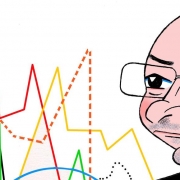Let’s Welcome The Deflation That Is Coming – It Helps Everyone Except Government And Its Cronies.
The greatest hoax perpetrated by the governing class on the rest of us is the Federal Reserve’s 2% inflation target. They are telling us that the dollar in our pocket will buy 2% less every year, or about 20% less in 10 years and 33% less in 20 years. And they are telling us this is a good thing. In fact, since the first year of the Federal Reserve in 2013, the average annual rate of decline of the spending power of the US dollar has been over 3%, so the Fed is beating its target. Your dollar has lost more than 95% of the purchasing power it represented in 1913.
We tolerate this because we have been taught (in the government’s own schools) since kindergarten that inflation is a good thing, and its opposite, deflation, is a bad thing. If there were to be deflation, then the purchasing power of the dollar in your pocket would be increasing not decreasing. So why would that be a bad thing?
Well, the Fed has a lot of myths they’s like you to buy into to support the idea of deflation as a bad thing. They include:
- The economy can’t grow when prices are falling. Wrong. Empirically, economic growth is not negatively correlated with falling prices. As one example, the US economy in the last third of the 19th Century grew strongly while overall prices were declining, so that real per capita income growth accelerated. And that’s the point: it is real income growth that people seek, not inflation-boosted nominal incomes measured in dollars that buy less and less every year.
- Companies can’t make a profit when prices are declining. Wrong. Profits are the difference between selling prices and costs. When both are declining, there is no reason why profit margins can not be maintained. Companies have become very smart at anticipating future prices and future costs during the unstable inflationary conditions induced by the Federal Reserve and other central banks, and they will be able to utilize the same forecasting skills when prices are falling.
- Deflation creates unemployment. Wrong. The economy can grow and therefore employment can grow amidst declining prices. Real wages can also grow in deflation. The only possible cause of unemployment in deflationary times would be the maintenance by government regulators of a mandatory minimum wage that was higher than the free market price that labor could command. The government would quickly find that such regulation would be unsustainable.
There are several more “deflation is bad” myths, but none are persuasive. So why are our governing class masters so adamant that inflation must be maintained? Because it is good (indeed vital) for government, and for its cronies in banking and the financial industry. Inflation is the fuel for never-ending government growth. When the Federal Reserve prints money (“expands the money supply”), which is the action that creates inflation, it goes straight to government spending. Government can issue unlimited amounts of debt for the Federal Reserve to buy (or “monetize”), in the confidence that (a) government can pay it off in future years with lower-value dollars, and (b) government will always have access to new Federal Reserve-created dollars in the future so it never needs tp stop or reduce spending. This inflation machine is the main engine of continued welfare state and warfare state expansion. Government just keeps getting bigger and bigger under conditions of inflation.
Similarly, the government’s closest cronies, the banks, are the next recipients of Federal Reserve-created money, which they can lend out at high interest rates to businesses and individuals, making profits on the spread. Banks lend every dollar they receive from the Fed nine times, multiplying the inflationary effect of newly printed money. In inflationary conditions, firms are happy to incur debt that they can repay in the future with lower value dollars. Business becomes more speculative as a result. In deflation, businesses are more likely to finance themselves with equity than debt, so that business becomes more soberly managed, more reliable and more likely to generate high quality growth. Both businesses and households become more likely to save now for investment later, taking economic and social power away from the Federal Reserve and the banks and putting it back in the hands of private citizens.
If government has such a vested interest in continued inflation, what are the signs that they might not be able to maintain their 100+ year record? There are three.
- Central Banks are beginning to realize that never-ending inflation is beginning to turn destructive to society. We reported here that the research arm of the Bank For International Settlements, the nation state central bankers’ own global central banker, has declared that the financial crashes and crises knowingly caused by unrestricted money printing should be brought to an end. At the same time, nation-state Central Banks like that of Japan are beginning to recognize that, in the anemic economic conditions they have brought about with their unrestrained money-printing, there comes a point where the citizens give up and cease to be economically productive.
- Technology-induced price deflation is becoming more and more pervasive. In the case of the declining prices / growing economy story of the US in the last third of the 19th Century, technology – in the form of railways, manufacturing machinery, electric lighting and telephones – played a large role. Today, we are undergoing a technology shift of comparable influence, with global trading platforms, declining transaction costs, and galloping automation, both software-based and hardware-based. Technology’s typical effect on prices is to reduce them not increase them.
- Today’s demographics are deflationary. As the baby boomer generation is retiring, they are starting to withdraw money from their retirement accounts to live on. Whatever they spend, they do so very carefully. Many countries, including Japan and China, are aging faster than they are adding to their affluence. Insofar as consumer spending influences price inflation, these conditions are anti-inflationary.
The signs are promising that we might be entering a period of price deflation, or at least price stability. If the rate of money printing by Central Banks continues to slow, and the downward influence of technology and demography on prices strengthens, then it could happen. Citizens will rejoice, and governments and banks will cringe, which is as it should be.





